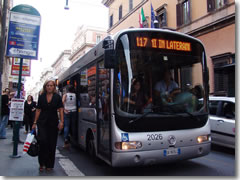- Places
- Plans
- Itineraries
- Experiences
 Minibus 117 stops at a fermata on Via del Corso in Rome.
Minibus 117 stops at a fermata on Via del Corso in Rome.Rome's bus and tram system is much more extensive than its subway system (Metro).
Both systems use the same tickets and passes.
Sadly, there is no free official map (at least not a decent one); invest in a mappa degli autobus at a newsstand, or simply scan the list of stops at your fermata (stop) to figure out which line(s) take you where you need to go.
Note: Some lines are express (and labeled as such on the signs) and won’t make all the stops.
Most buses in Rome run daily 5:30am to midnight, with a separate series of night buses whose route numbers are prefaced by an "N."
Unless you happen to be heading to the area immediately around the Spanish Steps, the bus is a far better bet than the Metro, as Rome's subway system doesn't really serve the core of the historic center but rather skirts its edges.
The single most useful bus line is probably the 40 (and its slower, local-stops cousin, the 64), which makes a beeline from Stazione Termini to the Vatican, passing Piazza Venezia (for central Rome) and Largo Argentina (for the historic Tiber Bend area) then across the river to Piazza Pia, right next to Castel Sant'Angelo.
Sadly, the bus does not then continue on all to way to a little square tucked behind the wall just outside Piazza San Pietro at St. Peter's. In its infinite idiocy, Rome's public transport board decided a few years ago to stop offering beeline direct bus service to the Vatican area. Piazza Pia is the new "waiting room" stop for visiting St. Peter's, the place where you pick up the "San Pietro express" shuttle bus 62, which just does a loop down the seven long (and exceedingly dull, souvenir-shop-lined) blocks from Piazza Pia to St. Peter's and back.
Old Rome hands might recognize this route as the same one plied by the famous no. 64 bus, nicknamed "The Wallet Eater," or "The Pickpocket Express" since it is always crammed with tourists, a fact that attracts Light-fingered Luigis like flies to the honeypot. It is. The 40 is merely an express version of the 64, which still chugs along the same route but stops more frequently.
Both, of course, remain thick with thieves, so be extra careful.
Also terribly useful for tourists are a trio of teensy electric buses that trundle through the streets of the centro storico (historic center).
Roman trams work just like buses, but few lines are of use to tourists—though tired feet might want to hop the no. 8 tram to get from its Largo Argentina terminus into Trastevere.
Planning your day: Rome wasn't built in a day, and you'd be hard-pressed to see it in that brief a time as well. Still, you can cram a lot into just a day or three.
To help you get the most out of your limited time in the Eternal City, here are some perfect itineraries, whether you have one, two, three, or four days to spend in Rome. » Rome itineraries
Share this page
Search ReidsItaly.com